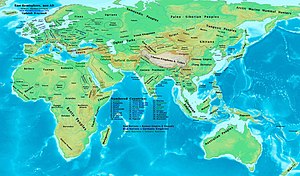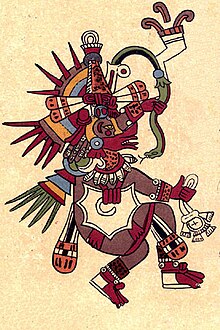10th century

| Millennium |
|---|
| 1st millennium |
| Centuries |
| Timelines |
| State leaders |
| Decades |
| Categories: |
|
Births – Deaths Establishments – Disestablishments |
The 10th century is the period from 901 to 1000 in accordance with the Julian calendar, and the last century of the 1st millennium.
In China the Song dynasty was established. The Muslim World, experienced a cultural zenith, especially in Spain under the Caliphate of Córdoba. Additionally, the 10th century was the zenith for the Byzantine and Bulgarian Empires.
Medievalist and historian of technology Lynn White said that "to the modern eye, it is very nearly the darkest of the Dark Ages", but concluded that ". . . if it was dark, it was the darkness of the womb."[1] Similarly, Helen Waddell wrote that the 10th century was that which "in the textbooks disputes with the seventh the bad eminence, the nadir of the human intellect."[2] In the 15th century, Lorenzo Valla described it as the Century of Lead and Iron and later Cardinal Baronius as the Leaden Century or Iron Century.
One estimate said that the tenth century saw fewer deaths in war (as a percentage of the total population) than any other century since 3000 BC.[3]
Events

- The beginning of the Medieval Warm Period
- The Byzantine empire reaches the height of its military and economic strength
Africa
- c. 909: The Fatimid Caliphate arises in eastern Algeria.
- c. 948: The Nri Kingdom in what is now Southeastern Nigeria starts.
- c. 980: Al-Azhar University is established in Cairo by the Fatimid dynasty.
- The Christian Nubian kingdom reaches its peak of prosperity and military power (Early history of Sudan)
Americas
- Collapse of the central lowland Maya civilization. Post-Classic Maya period begins. Chichen Itza becomes a regional capital on the Yucatán Peninsula
- Rise of the Toltecs in Mexico
- Golden age of the Ancestral Puebloans (Pueblo II Era)
- The Mississippian culture begins in present-day Southern United States
- In 987 Ah Mekat Tutul Xiu unified Uxmal, Mayapan, and Chichen Itza founding The League of Mayapan.
Eurasia
- Khazar kingdom is attacked and defeated by Kievan Rus (965)
Asia

- Buddhist temple construction commences at Bagan, Burma
- In 907, Sumbing volcano erupted, according to Rukam inscription.
- In 907, King Balitung created the Mantyasih inscription containing the list of Medang kings, moved the capital from Mamrati to Poh Pitu, and expanded Prambanan temple.
- In 910, Parantaka I of the Chola Dynasty drove out the Pandyan from southern India into Lanka (now Sri Lanka), which he also eventually conquered.
- In 914, The Warmadewa dynasty rules Bali.[4] (to 1080)
- In 919, the first use of gunpowder in battle occurred with the Chinese Battle of Langshan Jiang (Wolf Mountain River), where the Wuyue naval fleet under Qian Yuanguan defeated the Wu fleet. Qian had used flamethrowers ignited by gunpowder fuses to burn the Wu fleet.
- In 928, Ziyarid dynasty was established in northern Iran.
- In 928, During the reign of King Wawa, the capital of Medang Kingdom in Mataram was devastated, probably by the massive eruption of Mount Merapi.
- In 929, Mpu Sindok moved the seat of power of the Medang Kingdom from Mataram in Central Java to Tamwlang in East Java and established Isyana Dynasty. The shift was probably as a result of the eruption of Mount Merapi and/or invasion from Srivijaya.[5]
- In 930s, Persian Shia Buyid dynasty established and controlled central and western part of Iran as well as most of Iraq.
- In 936, Goryeo Dynasty unified Later Three Kingdoms of Korea.
- In 937, Mpu Sindok moved the capital again from Tamwlang to Watugaluh, both near bank of Brantas River in modern Jombang in East Java.
- In 960 Seljuks convert to Islam.
- In 975, Ghaznavids dynasty, as the first Turk Sultanate, was established in Central Asia.
- In 980's, Dynastic marriage between princess Mahendradatta of Javanese Isyanas and king Udayana of Balinese Warmadewas.
- Coastal cities on the Malay Peninsula are the seed for the first recorded Malay kingdoms
- In 990, King Dharmawangsa of Medang kingdom launches a naval invasion on Palembang in an unsuccessful attempt to conquer Srivijaya. (to 1006)
- In 990, Airlangga, son of King Udayana and Queen Mahendradatta was born in Bali.
- In 996, Dharmawangsa commissioned the translation of the Mahabharata into Old Javanese.[6]
- In 999, Samanid dynasty was defeated and conquered by Ghaznavids.
Europe



- Viking groups settle in northern France
- 907: Loire Vikings overrun Brittany; Breton court flees to the England of Edward the Elder.
- The Norse become Normans
- The Hungarian army destroys the Bavarian forces under duke Liutpold and king Louis the Child in the Battle of Pressburg. All the German force is annihilated.
- 911: Rollo granted County of Rouen by France: official foundation of Normandy.
- Foundation of Cluny, first federated monastic order
- Emperor Simeon the Great solidifies the First Bulgarian Empire as one of the most powerful states in Europe
- In 917 the Bulgarians destroyed the Byzantine army in the Battle of Anchialus, one of the bloodiest battles in the Middle Ages
- 927: official recognition of the first independent national Church in Europe, the Bulgarian Patriarchate
- 927: Kingdom of England becomes a unified state.
- c. 936: Gorm the Old becomes the first recognized king of Denmark, and thus the Danish Monarchy is founded.
- 936: Alan II, with support from Æthelstan, commences the reconquest of Brittany.
- 955 The Battle of Lechfeld (10 August 955) sees a decisive victory for Otto I the Great, King of the Germans, over the Hungarian harka Bulcsú and the chieftains Lél (Lehel) and Súr.
- Incursions of Magyar (Hungarian) cavalry throughout Western Europe (47 expeditions in Germany, Italy and France, 899–970)
- Mieszko I, first duke of Poland, baptised a Christian in 966
- Collapse of Great Moravia
- The medieval Croatian state becomes a unified kingdom under King Tomislav
- Swedish influence extends to the Black Sea
- Volodymyr I, Prince of Kievan Rus', baptised a Christian in 988
- Reindeer and bears become extinct in Britain
- Lions become extinct in Europe by this date, with the last dying in Caucasus.
- Second half of the 10th century – Page with David the Psalmist, from the Paris Psalter, is made. It is now kept at Bibliothéque Nationale, Paris.
- Late 10th or early 11th century – Archangel Michail, icon, is made. It is now kept at Treasury of the Cathedral of Saint Mark, Venice
Oceania
- Formation of the Tu'i Tonga Empire and of the Tuʻi Tonga dynasty in Tonga
Significant people

Africa
- Ubayd Allah al-Mahdi Billah, founder of the Fatamid dynasty of Egypt in 909
Americas
- Topiltzin Ce Acatl Quetzalcoatl, semi-legendaric Toltec ruler, (exact years of his life are unknown)

- Ah Mekat Tutul Xiu founded The League of Mayapan in 987.
Eurasia and Eastern Roman Empire
- Nicephorus II, Emperor of the Eastern Roman Empire (lived 912–969, reigned 963–969)
- John I Tzimisces, Emperor of the Eastern Roman Empire (lived 925–976, reigned 969–976)
- Basil II, Emperor of the Eastern Roman Empire, (lived 958–1025, reigned 976–1025)
Asia

- Adikavi Pampa an early Kannada language poet (born in 902)
- Ranna, an early Kannada language poet from India, (born in 949)
- Huyan Zan, Chinese general (died in 1000)
- Li Cheng, Chinese landscape painter
- Tailapa II, re-established the Western Chalukya Empire of India (reigned 973–997)
- Zhang Sixun, Chinese astronomer and mechanical engineer
- Ferdowsi, Persian poet
- Li Fang, Chinese scholar and encyclopedist (925–996)
- Emperor Taizu of Song, founder of the Chinese Song dynasty (lived March 21, 927–November 14, 976, reigned 960–976)
- Parantaka I, ruler of the Chola Dynasty of India – Tamil King (reigned 907–950)
- Raja Raja Chola I, ruler of the Chola Dynasty of India – Tamil King
- Avicenna, one of the foremost physician and philosopher of Medieval Era(c. 980 - 1037).[7]
- Al-Farabi, a Muslim polymath and one of the greatest scientists and philosophers (c. 872 – between 14 December, 950 and 12 January, 951).[8]
- Alhazen, a Muslim scientist and mathematician, (965 in Basra - c. 1039 in Cairo)
- Abu Rayhan Biruni, a Muslim scientist, (born 5 September 973 in Kath, Khwarezm, died 13 December 1048 in Ghazni)
- Taejo of Goryeo, founder of the Korean Goryeo Dynasty (lived January 31, 877 – July 4, 943, reigned 918–943)
Europe
- Harald Fairhair, king of Norway, united Norway in 872 and remained its ruler until 933. One of the most powerful lords of Europe at the time.
- Vladimir I, Prince of Kievan Rus (lived 958–1015)
- Tomislav, king of Croatia, united the medieval Croatian state into the Kingdom of Croatia, crowned in 925
- Abd-ar-rahman III of Cordoba
- Simeon the Great, Emperor of Bulgaria (reigned 893–927)
- Otto I the Great, Holy Roman Emperor (lived 912–973, reigned 936–973)
- King Edmund I of England (lived 921–946, reigned 939–946)
- Hugh Capet (lived 938–996), first Capetian King of France
- Géza of Hungary, ruler of the Magyars (lived 940–997, reigned 970–997)
- Otto II, Holy Roman Emperor (lived 955–983, reigned 973–983)
- Theophanu, wife of Otto II, mother and Regent of Otto III, (lived 956–991, reigned 983–991)
- Tsar Samuil of Bulgaria (lived 958–1014, reigned 976–1014)
- Otto III, Holy Roman Emperor (lived 980–1002, reigned 983–1002)
- Erik the Red, Norwegian explorer, founded Greenland
- Leif Eiriksson, Norwegian explorer, son of Erik the Red, made the first European attempt to settle in America.
- Olav Tryggvason becomes the first king to try to Christianize Norway, dies at the Battle of Svolder in 1000.
Oceania
- 'Aho'eitu (early 10th century), first king of the Tuʻi Tonga
Inventions, discoveries, introductions

- List of 9th-10th centuries inventions
- 10th century-12th century - Seated Guaryin Bodhisattva, is made. Liao dynasty. It is now kept at The Nelson-Atkins Museum of Art, Kansas City, Missouri.
- Construction begins on the Brihadeeswarar Temple of India, during the reign of Rajaraja Chola I
- The first pound lock is invented by the Chinese engineer Qiao Weiyo, improving the canal lock system.
- Fire arrows are invented by the Chinese.
- Earliest known occurrence in Mexico of Lost-wax casting.
- Three of the Four Great Books of Song are published (the last one in 1013), which were enormous Chinese encyclopedias having millions of written Chinese characters each.
- Hops first mentioned in connection with beer brewing
- Zhang Sixun of China uses for the first time liquid mercury (element) instead of water to power the escapement mechanism rotating an armillary sphere, since liquid mercury does not freeze easily like water during winter, and does not rust metal parts
Decades and years
Notes
- ^ Quoted in The Tenth Century: How Dark the Dark Ages?, edited by Robert Sabatino Lopez. Holt, Rinehart and Winston: 1959.
- ^ The Wandering Scholars. Constable and Co: London, 1927.
- ^ democraticpeace.wordpress.com/2009/01/27/why-the-20th-century-was-the-bloodiest-of-all/
- ^ Soekmono, R, Drs., Pengantar Sejarah Kebudayaan Indonesia 2, 2nd ed. Penerbit Kanisius, Yogyakarta, 1973, 5th reprint edition in 1988 p.52
- ^ Spuler, Bertold; F.R.C Bagley. The Muslim world : a historical survey, Part 4. Brill Archive. p. 252. ISBN 978-90-04-06196-5.
- ^ Soekmono, R, Drs., Pengantar Sejarah Kebudayaan Indonesia 2, 2nd ed. Penerbit Kanisius, Yogyakarta, 1973, 5th reprint edition in 1988 p.51
- ^ "Avicenna", in Encyclopaedia Iranica, Online Version 2006". Iranica.com. Retrieved 2010-01-19.
- ^ Corbin, Henry; Nasr, Hossein; Yahya, Utman (2001). History of Islamic Philosophy. Kegan Paul. ISBN 978-0-7103-0416-2.
Further reading
- Heinrich Fichtenau: Living in the Tenth century: Mentalities and Social Orders (transl. Patrick J. Geary; Chicago cool London: 1991).
